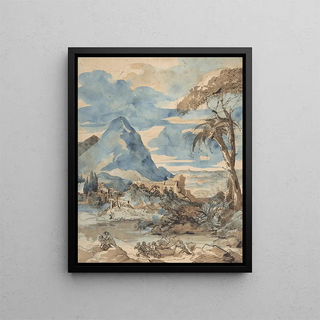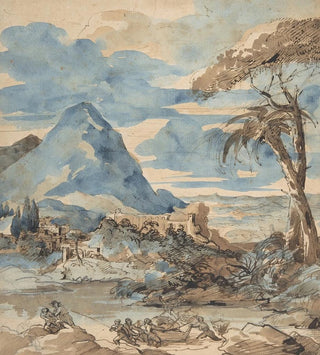Art print | Landscape with Fishermen - Théodore Géricault


View from behind

Frame (optional)
In the vast panorama of art history, certain works manage to capture the very essence of nature and human emotions. "L Paysage avec des pêcheurs" by Théodore Géricault is one of those creations that transcends the simple frame of painting. Created in the early 19th century, this piece invites us to contemplate a bucolic scene where the tranquility of fishermen blends with the majesty of a natural landscape. Géricault, known for his emotional engagement and his ability to evoke poignant stories, here manages to create an almost palpable atmosphere, where the viewer is transported to the water's edge, at the heart of a harmony between man and his environment.
Style and uniqueness of the work
Géricault's style in "L Paysage avec des pêcheurs" is distinguished by meticulous attention to detail and a color palette that evokes both serenity and movement. The shades of blue and green, typical of romantic landscapes, intertwine to form a lively tableau, where each brushstroke seems to breathe. The fishermen, depicted with remarkable delicacy, are both individual figures and symbols of a simple life rooted in nature. The composition, balanced and dynamic, guides the viewer's gaze across the painting, thus creating a visual narration that invites contemplation. This choice of subject and refined execution testify to Géricault's originality, who manages to combine realism and poetry in a single work.
The artist and his influence
Théodore Géricault, an emblematic figure of the Romantic movement, knew how to mark his era with powerful and emotional works. Born in 1791, he was influenced by the political and social upheavals of his time, which is reflected in his art. Although "L Paysage avec des pêcheurs" is less well-known than his emblematic works like "The Raft of the Medusa," this painting reveals a more intimate facet of his creative genius. Géricault drew inspiration from the masters of the past while forging his own style, making him a precursor for many artists who followed.

Matte finish

View from behind

Frame (optional)
In the vast panorama of art history, certain works manage to capture the very essence of nature and human emotions. "L Paysage avec des pêcheurs" by Théodore Géricault is one of those creations that transcends the simple frame of painting. Created in the early 19th century, this piece invites us to contemplate a bucolic scene where the tranquility of fishermen blends with the majesty of a natural landscape. Géricault, known for his emotional engagement and his ability to evoke poignant stories, here manages to create an almost palpable atmosphere, where the viewer is transported to the water's edge, at the heart of a harmony between man and his environment.
Style and uniqueness of the work
Géricault's style in "L Paysage avec des pêcheurs" is distinguished by meticulous attention to detail and a color palette that evokes both serenity and movement. The shades of blue and green, typical of romantic landscapes, intertwine to form a lively tableau, where each brushstroke seems to breathe. The fishermen, depicted with remarkable delicacy, are both individual figures and symbols of a simple life rooted in nature. The composition, balanced and dynamic, guides the viewer's gaze across the painting, thus creating a visual narration that invites contemplation. This choice of subject and refined execution testify to Géricault's originality, who manages to combine realism and poetry in a single work.
The artist and his influence
Théodore Géricault, an emblematic figure of the Romantic movement, knew how to mark his era with powerful and emotional works. Born in 1791, he was influenced by the political and social upheavals of his time, which is reflected in his art. Although "L Paysage avec des pêcheurs" is less well-known than his emblematic works like "The Raft of the Medusa," this painting reveals a more intimate facet of his creative genius. Géricault drew inspiration from the masters of the past while forging his own style, making him a precursor for many artists who followed.






